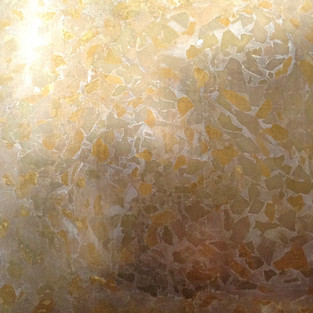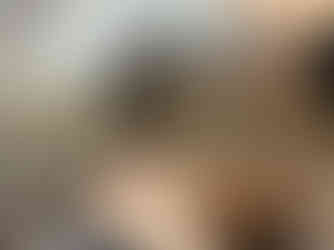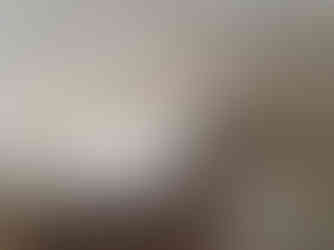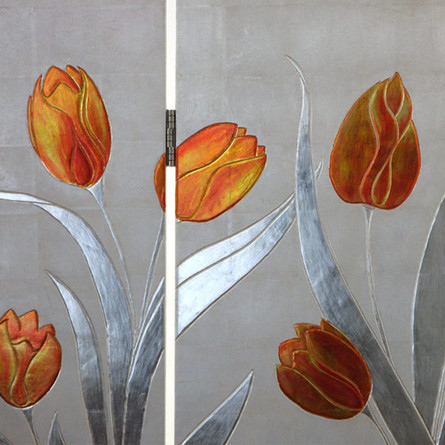Artelier Interview: Janine Lambers on Expressing Nature through Gold
- david
- Mar 7, 2021
- 10 min read
As international art consultants, Artelier specialises in curating art for luxury residential, hospitality, yacht and aviation projects. Artelier's feature wall collection – Artist Walls – presents a collection of artists whose originality of ideas and dedication to their materials makes them true contemporary masters. Through collaborating with Artelier, they have created large-scale custom art commissions that reinvent the concept of the mural for the modern age, pushing the possibilities for feature wall art.
Janine Lambers' intricate gold leaf murals present an ethereal view of the natural world, captivating viewers with their sublime warm glow. The theme of nature is central to Lambers' work, as she draws inspiration from observing its ever-changing cycles. Nature itself interacts with the artworks, as the changing light of the day and seasons brings new subtleties to the gold leaf. Equally important for Lambers is drawing inspiration from the past, as she incorporates ancient techniques and artistic styles into her gilded artworks. In this interview, she discusses how her ideas develop, her meditative approach to both gilding and nature, and the breadth of her inspirations.

Where do you draw inspiration for your work, and what is your process for evolving ideas?
Art for me has come intuitively. I had not really planned on becoming an artist, as I trained to become a gilder and conservator, and for years worked with craftspeople, clients, galleries, and auction houses which deepened my craft. But with time, inspiration started to bubble up to the surface. I started to see scenes of nature in gold leaf, started to look at the sun, flowers, mountains and humans wondering how I can translate all that into a gilded painting.
I began experimenting with the techniques I had learned to create new concepts in two-dimensional and three-dimensional artworks. My knowledge of gold leaf techniques taught me when to use sgraffito, when punch work, how to escape the limitation of the 8.5cm x 8.5cm square leaf, and so on. My meditation practice also is a well of inspiration. Meditation is also important to my methods, teaching me when I need to step away, as art depends heavily on when to stop – often 'less is more'.
I love what you said about “seeing scenes of nature in gold leaf”. How do scenes of nature inform your art?
Something I tackled fairly early on was trying to imitate the radiance of the sun. I live in a green area, up the Hudson valley in New York. We have the river here, and rolling green Highlands, and nature was a big factor in why we chose to live here. For me, it’s all about observation – observing nature, how it constantly changes, and that hugely informs my art.
When you observe nature, you see it bud in spring, the vibrance of summer, and then how it slowly ends up dying into winter. I spend a lot of time outside, and go for walks every day. All of a sudden, when you try to stop thinking and just perceive, you begin to see nature differently. Those are the images that stick with me; all that flows into my art.
People often form a personal response when representing nature, depending on how it makes them feel as well as how they see it. Is perception an important experience in your process?
You mention a very important word – it's the feeling. Feeling is essentially our true understanding of life. If we are able to get in touch with our feelings on a more precise level, I think it would guide us through a less challenging life, as we would intuitively feel what our own true nature is. We have a layered, learned response to many things, as we are exposed to adults, parents, teachers who have a certain idea of how we should be taught. I think on some levels we are trying too hard to rationalise many things, led by the notion that something has to make sense.
In a way, I have always felt that the artistic path or artistic expressions have nothing to do with thinking about something, or having a rational idea about it – at least not for me. It just all comes out of an intuitive feeling, and all of a sudden an image can pop up in my mind, and it feels as though it’s not me who has conjured it up at all. Yet, I do go about creating art methodically, as that's the training of my craft background. When I begin, I plan the steps I have to take to get there. But the rest of the process is what many would call “subconscious”, although I would say it is the “conscious” process; that’s the way I view the world.

So, your craft practice has informed your art not only with the skills, but also by providing that methodological approach for an overall very intuitive process?
Yes, I would agree with that; it provides a methodological approach, once the subconscious (or as I believe, the conscious mind,) has actually produced the idea. The way that it is produced is actually through letting go of ideas. Unlike realist painters, for instance, who believe that how they see the person is how they should paint their portrait, for me the ideas are more intangible and show up by themselves.
Having said that, I'm very happy to work with other people's ideas or suggestions – this in itself is a huge opportunity for inspiration. Sometimes when someone comes to me with a particular image that they seek, and I immediately begin to see it in my own techniques. That kind of collaboration is something I actually enjoy very much. With Artelier, it happened for instance on the Mt. Fuji installation for the yacht M/Y Aurora Borealis, and similarly for an upcoming project on a BBJ Max.

Could you describe how the project for the Mt. Fuji 5m wall mural evolved, from your perspective?
I received a call from Artelier and we discussed a particular art piece that I had previously created, and Artelier saw an opportunity to develop it into a landscape. I immediately started to see it in my mind's eye. I was asked me to draw up a variety of sketches, and after that we put together a few samples including technical samples and a gold colour sample palette. Once the project was confirmed, the rest was history, as they say!
Working on such a large surface is an artist's dream come true. Initially it is intimidating, but then the decades’ worth training and honing of one's profession kicks in, and I began tackling it as I always do with a project. I create a plan, make samples and work very methodically. For a number of months, I worked closely with Artelier sussing out the details; this included practical discussions such as where to produce the artwork, as the project will be delivered in Europe while I live in the US. I contacted a few of my artist friends and ended up creating the work in Helge Meuthien's lacquering workshop in Hamburg, Germany. Helge was an instrumental part in the creation of the wall, and gave me the space to work in his studio. From then on everything started to fall into place. As with everything in life, there were folds to be ironed out and obstacles to overcome, but in the end we delivered a spectacular wall.
Often your work is created entirely with gold leaf, using different shades to build a composition. Could you discuss how you create such an artwork, and what you enjoy about that process?
Gold leaf has many shades and they have an immediate harmony. Sometimes it wants to be subtle, and other times bold. I like the subtleness between the background, which is often an earth pigment based surface, and the gold leaf. It plays with shape, defining it, and yet doesn't at the same time. Observing this effect can become meditative and contemplative.
Creating it is an organic process. Firstly, I usually work with simple outlines, without too much detail and focusing on the large shapes. From there I work toward details, adding it gradually. While I work, there's a lot of wandering back and forth and side to side, to observe from all angles how the artwork develops. Creating depth with only gold leaf is somewhat challenging, but different techniques allow that, too.
When you are building a composition, how do you create the illusion of depth? What techniques do you use?
There are many techniques to consider. Definitely it can be achieved by using different shades, and considering how you put colours together. There's also the possibility of using the sheen, as in whether the gold leaf has a high sheen or a matte sheen, which can also can create that illusion. You can create different spaces through the sheen, depending on whether it is burnished or flat. By manipulating the thickness of gold leaf this can be achieved also.
Texture is also important in enhancing depth and creating different spaces. I can create different textures through brushwork and techniques, such as punch work. The texture of the surface underneath can also be used. The surface does not necessarily have to be smooth all the time, it can have different textures, such as using pastiglia which is a raised gesso; the textures can counteract to give the illusion of different depths.
What is the experience of seeing a work come to life as it evolves throughout the day with changing light?
That is one of the things I have always absolutely loved about gold leaf. You can even walk into a room at night, and if there is the slightest light source, you will immediately see something glowing. I have never found that kind of glow in any other material. I see that glow in the artworks that I have here in my home, and you can immediately feel it when you enter a space. The glow changes throughout the day and in different rooms; as the sun moves, the light in the morning is much clearer than the light in the evening. They look very different with the weather too, such as depending on whether it’s a grey day or a sunnier day. You can observe it changing, watching how all the different gold leaf pieces constantly play with the light. I think that for the Mt Fuji piece that effect must be phenomenal; you can even see the difference of how the light interacts with the gold in different spheres of the planet, as you sail around the world.
As a material, it also always reflects everything. You can see all the different tones of the room interacting with the surface. That also plays on the idea of illusion, of perception, on what we think we know in this world. That’s also what I like about gold, how it reflects back to us. It is quite a transcendent experience. Whilst I was working on the Mt Fuji piece in Hamburg, that was amazing, as I had a lot of time in the workshop on my own and went in at all different times of day. It becomes quite something when the light hits it. It is enlightening, an explosion of such a deep glow.
You have said previously that you are inspired by history as well as nature. Do you take inspiration from any art historical references?
For sure; I am inspired by Gustav Klimt, Jean Dunand, A.A. Rateau, as well as Japanese and Chinese traditional art forms such as screens and scrolls, to name a few masters. But I also find inspiration in the work of lesser known artists which I see online or in galleries. I am very inclusive when it comes to expressions of art, as I feel that everyone has a spark of ingenuity whether it is expressed in a traditional, impressionistic, surrealistic, modern, graffiti or contemporary way. It is all inspiring and humbling to me when it is well executed.
How do historical references inform your current work?
At the moment, for instance, I am looking into the feminine figure and also into meditation, specifically the ancient teaching of Dhamma – the "law of nature". Dhamma is a lifestyle, a way of aspiring to conduct oneself from moment to moment, a lifestyle that has permeated my life over the past one and a half to two decades. It is intimately connected with how I make art. A large part of Dhamma is the reality that life is impermanent, as well as “seeing reality for what it is", and these wisdoms are always with me. I express impermanence in using silver leaf, which tarnishes and changes over time if left unvarnished, while purity and truth are expressed in genuine gold leaf, palladium or platinum leaf.
In that sense, I look at historical notions of what are commonly called “virtues”, such as what in Christianity they call the ten commandments. I take their symbolism and attribute it into art. For example I have one artworks that portrays white lilies, which historically has often a symbol for purity or morality, the teaching that we are supposed to lead a fairly moral life. In this way, I take a certain philosophy, and I break it down into symbols which I incorporate into my art.
More broadly in terms of history, I've been interested not just in one particular century, but looking into all kinds of art - from ancient art, to what is being created now. I remember once working on restoring an Ancient Egyptian sarcophagus, using my knowledge of their techniques. Sometimes when I have an idea, I look at historical expressions of it, seeing how it was interpreted 300, 400, 500 years ago. I'm especially interested in Chinese and Japanese scrolls, as I love reading up about the meaning behind the artworks and what the history of that particular period was.
Which elements of Chinese and Japanese scrolls appeal to you?
Usually they present almost sage-like figures, who are lone wanderers and emerged into nature. Again, these align with forms of spirituality. I love the traditional Chinese way of painting or drawing the mountains, as well as the relationship between a figure and the mountains. The figures are usually so insignificant compared to nature. Nowadays, we almost present it the other way around. Their reverence for nature I find very inspiring.
I also like the way that the Chinese and Japanese traditional artists express simple things, like waves. The idea of how simple the line can be, how incredibly subtle, to create shapes. This approach is fascinating to me. And yet, at the same time, what you see is so clear, so expressive and detailed. As well as scrolls, I’m also really drawn to Chinese and Japanese room divider screens and panels; sometimes you have whole rooms that are panels. One of the first artworks I produced interestingly enough was a screen divider, depicting poppies. That style and their ideas have inspired me from the beginning.
Janine Lambers has collaborated with Artelier's art consultancy on numerous artwork commissions for interiors, and is included as part of our 'Artist Walls' collection – visit her dedicated page on our website here. The second half of her interview, about the ancient craft of gilding and Lambers' artistic journey, can be found here.
Artelier's art consultancy plays a fundamental role in all artwork commissions, and as the appointed art consultant for projects we bring artists and clients together to achieve forward-thinking and intelligently curated art installations. Discover more about our feature wall collection: Artist Walls.













































